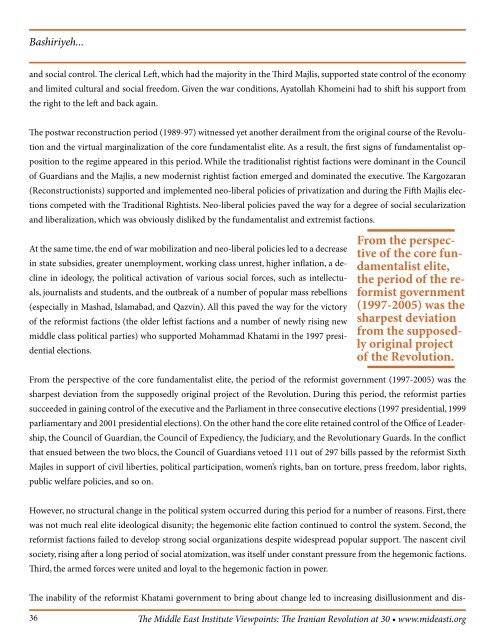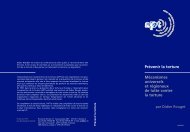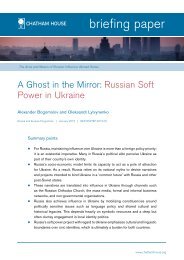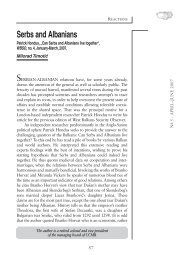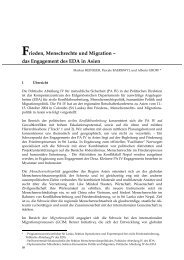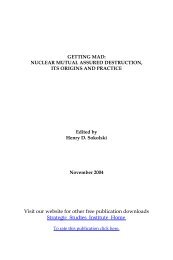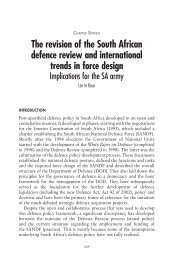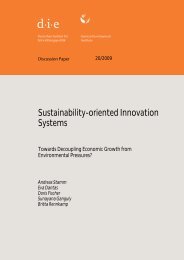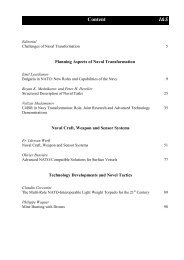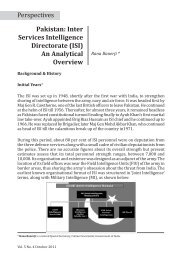The Iranian Revolution at 30
The Iranian Revolution at 30
The Iranian Revolution at 30
You also want an ePaper? Increase the reach of your titles
YUMPU automatically turns print PDFs into web optimized ePapers that Google loves.
Bashiriyeh...<br />
and social control. <strong>The</strong> clerical Left, which had the majority in the Third Majlis, supported st<strong>at</strong>e control of the economy<br />
and limited cultural and social freedom. Given the war conditions, Ay<strong>at</strong>ollah Khomeini had to shift his support from<br />
the right to the left and back again.<br />
<strong>The</strong> postwar reconstruction period (1989-97) witnessed yet another derailment from the original course of the <strong>Revolution</strong><br />
and the virtual marginaliz<strong>at</strong>ion of the core fundamentalist elite. As a result, the first signs of fundamentalist opposition<br />
to the regime appeared in this period. While the traditionalist rightist factions were dominant in the Council<br />
of Guardians and the Majlis, a new modernist rightist faction emerged and domin<strong>at</strong>ed the executive. <strong>The</strong> Kargozaran<br />
(Reconstructionists) supported and implemented neo-liberal policies of priv<strong>at</strong>iz<strong>at</strong>ion and during the Fifth Majlis elections<br />
competed with the Traditional Rightists. Neo-liberal policies paved the way for a degree of social seculariz<strong>at</strong>ion<br />
and liberaliz<strong>at</strong>ion, which was obviously disliked by the fundamentalist and extremist factions.<br />
At the same time, the end of war mobiliz<strong>at</strong>ion and neo-liberal policies led to a decrease<br />
in st<strong>at</strong>e subsidies, gre<strong>at</strong>er unemployment, working class unrest, higher infl<strong>at</strong>ion, a decline<br />
in ideology, the political activ<strong>at</strong>ion of various social forces, such as intellectuals,<br />
journalists and students, and the outbreak of a number of popular mass rebellions<br />
(especially in Mashad, Islamabad, and Qazvin). All this paved the way for the victory<br />
of the reformist factions (the older leftist factions and a number of newly rising new<br />
middle class political parties) who supported Mohammad Kh<strong>at</strong>ami in the 1997 presidential<br />
elections.<br />
From the perspective<br />
of the core fundamentalist<br />
elite,<br />
the period of the reformist<br />
government<br />
(1997-2005) was the<br />
sharpest devi<strong>at</strong>ion<br />
from the supposedly<br />
original project<br />
of the <strong>Revolution</strong>.<br />
From the perspective of the core fundamentalist elite, the period of the reformist government (1997-2005) was the<br />
sharpest devi<strong>at</strong>ion from the supposedly original project of the <strong>Revolution</strong>. During this period, the reformist parties<br />
succeeded in gaining control of the executive and the Parliament in three consecutive elections (1997 presidential, 1999<br />
parliamentary and 2001 presidential elections). On the other hand the core elite retained control of the Office of Leadership,<br />
the Council of Guardian, the Council of Expediency, the Judiciary, and the <strong>Revolution</strong>ary Guards. In the conflict<br />
th<strong>at</strong> ensued between the two blocs, the Council of Guardians vetoed 111 out of 297 bills passed by the reformist Sixth<br />
Majles in support of civil liberties, political particip<strong>at</strong>ion, women’s rights, ban on torture, press freedom, labor rights,<br />
public welfare policies, and so on.<br />
However, no structural change in the political system occurred during this period for a number of reasons. First, there<br />
was not much real elite ideological disunity; the hegemonic elite faction continued to control the system. Second, the<br />
reformist factions failed to develop strong social organiz<strong>at</strong>ions despite widespread popular support. <strong>The</strong> nascent civil<br />
society, rising after a long period of social <strong>at</strong>omiz<strong>at</strong>ion, was itself under constant pressure from the hegemonic factions.<br />
Third, the armed forces were united and loyal to the hegemonic faction in power.<br />
<strong>The</strong> inability of the reformist Kh<strong>at</strong>ami government to bring about change led to increasing disillusionment and dis-<br />
36 <strong>The</strong> Middle East Institute Viewpoints: <strong>The</strong> <strong>Iranian</strong> <strong>Revolution</strong> <strong>at</strong> <strong>30</strong> • www.mideasti.org


